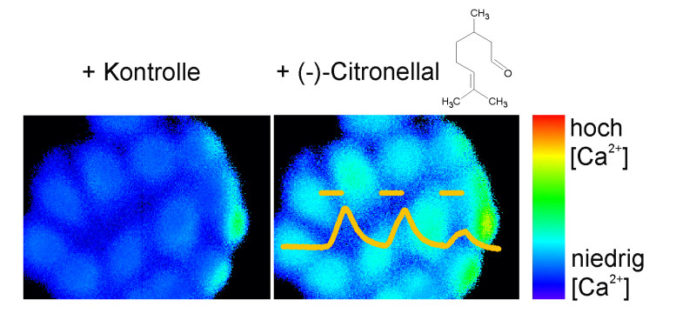
As main component of essential oils, terpenes can inhibit the growth of different cancer cells. Researchers from the Ruhr-University Bochum headed by Prof Dr Dr Dr Hanns Hatt have analysed this process in liver cancer cells in detail. They shed light upon the molecular mechanisms that resulted in cancer cells stop growing, following the application of (-)-citronellal, and they proved that the olfactory receptor OR1A2 is the crucial molecule for that purpose. In future, the olfactory receptor could serve as target for liver cancer diagnosis and therapy. The researchers report their findings in the journal Archives of Biochemistry and Biophysics.
Essential oils protect not only from bacteria, viruses and fungi
Essential oils occur in many plants, protecting them through their antibacterial, antiviral and fungicidal properties. It has been recently discovered that terpenes, the oils’ main components, can also inhibit the growth of different cancer cells, including liver cancer. Their function had not previously been fully understood.
Olfactory receptors not just in the nose
Terpenes can trigger signalling processes in cells by activating olfactory receptors. Those receptors are mainly located in the nose, but they have been proved to occur in all types of human tissue, including skin, prostate and spermatozoa. Carcinogenesis and cancer growth are likewise significantly affected by terpenes, even though it has not been understood which function exactly they fulfil.
Terpene triggers signalling pathway in the cell
In order to find this out, the researchers from Bochum utilised a cellular model of hepatocellular carcinoma, a common liver tumour. They exposed the cells to a subset of terpenes with different concentrations, and monitored their reactions. It emerged that two of the eleven terpenes tested resulted in a significant increase in calcium concentration in the cells: (-)-citronellal and citronellol. During a follow-up analysis, the researchers focused on (-)-citronellal and scanned for a receptor into which the terpene has to fit like a key into a lock. They demonstrated that the decisive olfactory receptor OR1A2 occurs in liver cells and is responsible for detection of the citrus scent and cellular reaction. If the option for producing that receptor had been removed from the cells, they did no longer react to the terpene. The researchers, moreover, succeeded in tracking the signalling pathway which the terpene uses for increasing calcium concentration inside the cells, thus reducing cell growth. “These results are yet another example for the significance of olfactory receptors outside the nose, and they give rise to hope that new drugs with no severe side effects may be developed for cancer therapy.”
Background
The hepatocellular carcinoma is the most common primary tumour of the liver. It is the third most common tumour-induced cause of death. According to current estimations, approx. 8,900 people (6,200 men, 2,700 women) contract this form of cancer in Germany every year.
Story Source:
The above story is based on materials provided by Ruhr-Universitaet-Bochum. Note: Materials may be edited for content and length.
Journal Reference:
- Désirée Maßberg, Annika Simon, Dieter Häussinger, Verena Keitel, Günter Gisselmann, Heike Conrad, Hanns Hatt. Monoterpene (−)-citronellal affects hepatocarcinoma cell signaling via an olfactory receptor. Archives of Biochemistry and Biophysics, 2015; 566: 100 DOI: 10.1016/j.abb.2014.12.004
